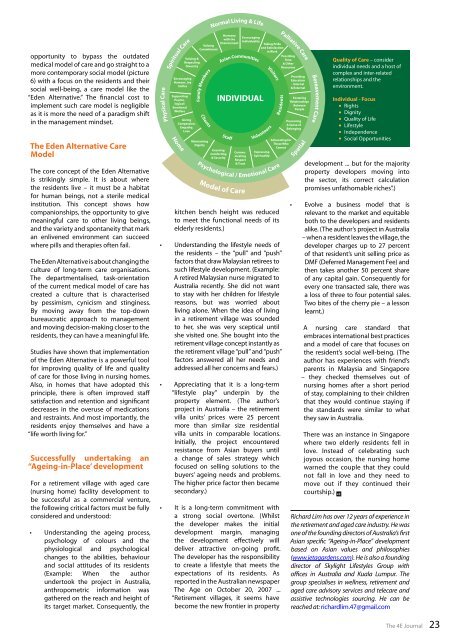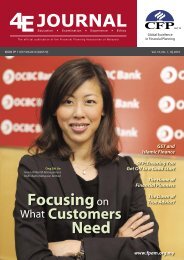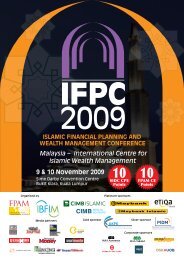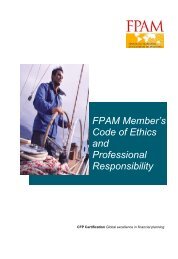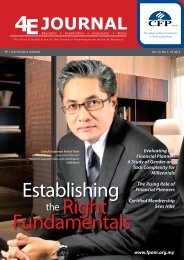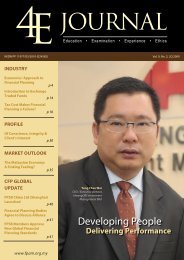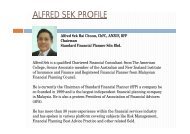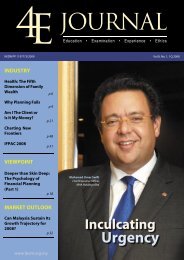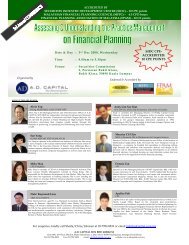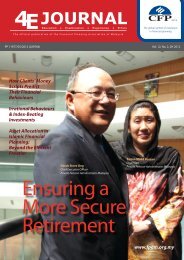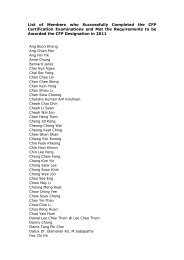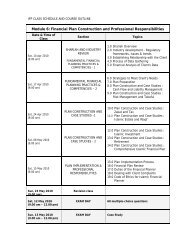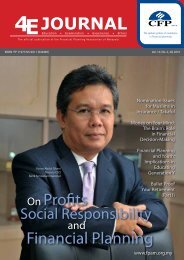Vol 10, No 4 - Financial Planning Association of Malaysia
Vol 10, No 4 - Financial Planning Association of Malaysia
Vol 10, No 4 - Financial Planning Association of Malaysia
You also want an ePaper? Increase the reach of your titles
YUMPU automatically turns print PDFs into web optimized ePapers that Google loves.
<strong>No</strong>rmal Living & Life<br />
opportunity to bypass the outdated<br />
medical model <strong>of</strong> care and go straight to a<br />
more contemporary social model (picture<br />
6) with a focus on the residents and their<br />
social well-being, a care model like the<br />
“Eden Alternative.” The financial cost to<br />
implement such care model is negligible<br />
as it is more the need <strong>of</strong> a paradigm shift<br />
in the management mindset.<br />
The Eden Alternative Care<br />
Model<br />
The core concept <strong>of</strong> the Eden Alternative<br />
is strikingly simple. It is about where<br />
the residents live – it must be a habitat<br />
for human beings, not a sterile medical<br />
institution. This concept shows how<br />
companionships, the opportunity to give<br />
meaningful care to other living beings,<br />
and the variety and spontaneity that mark<br />
an enlivened environment can succeed<br />
where pills and therapies <strong>of</strong>ten fail.<br />
The Eden Alternative is about changing the<br />
culture <strong>of</strong> long-term care organisations.<br />
The departmentalised, task-orientation<br />
<strong>of</strong> the current medical model <strong>of</strong> care has<br />
created a culture that is characterised<br />
by pessimism, cynicism and stinginess.<br />
By moving away from the top-down<br />
bureaucratic approach to management<br />
and moving decision-making closer to the<br />
residents, they can have a meaningful life.<br />
Studies have shown that implementation<br />
<strong>of</strong> the Eden Alternative is a powerful tool<br />
for improving quality <strong>of</strong> life and quality<br />
<strong>of</strong> care for those living in nursing homes.<br />
Also, in homes that have adopted this<br />
principle, there is <strong>of</strong>ten improved staff<br />
satisfaction and retention and significant<br />
decreases in the overuse <strong>of</strong> medications<br />
and restraints. And most importantly, the<br />
residents enjoy themselves and have a<br />
“life worth living for.”<br />
Successfully undertaking an<br />
“Ageing-in-Place’ development<br />
For a retirement village with aged care<br />
(nursing home) facility development to<br />
be successful as a commercial venture,<br />
the following critical factors must be fully<br />
considered and understood:<br />
• Understanding the ageing process,<br />
psychology <strong>of</strong> colours and the<br />
physiological and psychological<br />
changes to the abilities, behaviour<br />
and social attitudes <strong>of</strong> its residents<br />
(Example: When the author<br />
undertook the project in Australia,<br />
anthropometric information was<br />
gathered on the reach and height <strong>of</strong><br />
its target market. Consequently, the<br />
Physical Care<br />
Spiritual Care<br />
Encouraging<br />
Humour, Joy<br />
Smiles<br />
Supporting<br />
Psychological/<br />
Emotional<br />
Welfare<br />
Home<br />
Valuing &<br />
Respecting<br />
Diversity<br />
Giving<br />
Compassion,<br />
Empathy,<br />
Love<br />
Valuing<br />
Commitment<br />
Family Members<br />
Clients<br />
Harmony<br />
with the<br />
Environment<br />
Asian Communities<br />
INDIVIDUAL<br />
Staff<br />
Maintaining<br />
Dignity<br />
Ensuring<br />
Comforting<br />
& Security<br />
Communicating<br />
Respect<br />
& Trust<br />
Model <strong>of</strong> Care<br />
Encouraging<br />
Individuality<br />
Taking Pride<br />
and Satisfaction<br />
in Work<br />
Providing<br />
Visitors<br />
<strong>Vol</strong>unteers<br />
Residents<br />
kitchen bench height was reduced<br />
to meet the functional needs <strong>of</strong> its<br />
elderly residents.)<br />
• Understanding the lifestyle needs <strong>of</strong><br />
the residents – the “pull” and “push”<br />
factors that draw <strong>Malaysia</strong>n retirees to<br />
such lifestyle development. (Example:<br />
A retired <strong>Malaysia</strong>n nurse migrated to<br />
Australia recently. She did not want<br />
to stay with her children for lifestyle<br />
reasons, but was worried about<br />
living alone. When the idea <strong>of</strong> living<br />
in a retirement village was sounded<br />
to her, she was very sceptical until<br />
she visited one. She bought into the<br />
retirement village concept instantly as<br />
the retirement village “pull” and “push”<br />
factors answered all her needs and<br />
addressed all her concerns and fears.)<br />
• Appreciating that it is a long-term<br />
“lifestyle play” underpin by the<br />
property element. (The author’s<br />
project in Australia – the retirement<br />
villa units’ prices were 25 percent<br />
more than similar size residential<br />
villa units in comparable locations.<br />
Initially, the project encountered<br />
resistance from Asian buyers until<br />
a change <strong>of</strong> sales strategy which<br />
focused on selling solutions to the<br />
buyers’ ageing needs and problems.<br />
The higher price factor then became<br />
secondary.)<br />
• It is a long-term commitment with<br />
a strong social overtone. (Whilst<br />
the developer makes the initial<br />
development margin, managing<br />
the development effectively will<br />
deliver attractive on-going pr<strong>of</strong>it.<br />
The developer has the responsibility<br />
to create a lifestyle that meets the<br />
expectations <strong>of</strong> its residents. As<br />
reported in the Australian newspaper<br />
The Age on October 20, 2007 ...<br />
“Retirement villages, it seems have<br />
become the new frontier in property<br />
Time<br />
& Other<br />
Resources<br />
Advocating for<br />
Those Who<br />
Cannot<br />
Expressing<br />
Spirituality<br />
Psychological / Emotional Care<br />
Palliative Care<br />
Providing<br />
Education<br />
- Internal<br />
& External<br />
Fostering<br />
Relationships<br />
Between<br />
People<br />
Promoting<br />
A Sense <strong>of</strong><br />
Belonging<br />
Spatial<br />
Bereavement Care<br />
Quality <strong>of</strong> Care – consider<br />
individual needs and a host <strong>of</strong><br />
complex and inter-related<br />
relationships and the<br />
environment.<br />
Individual - Focus<br />
Rights<br />
Dignity<br />
Quality <strong>of</strong> Life<br />
Lifestyle<br />
Independence<br />
Social Opportunities<br />
development ... but for the majority<br />
property developers moving into<br />
the sector, its correct calculation<br />
promises unfathomable riches”.)<br />
• Evolve a business model that is<br />
relevant to the market and equitable<br />
both to the developers and residents<br />
alike. (The author’s project in Australia<br />
– when a resident leaves the village, the<br />
developer charges up to 27 percent<br />
<strong>of</strong> that resident’s unit selling price as<br />
DMF (Deferred Management Fee) and<br />
then takes another 50 percent share<br />
<strong>of</strong> any capital gain. Consequently for<br />
every one transacted sale, there was<br />
a loss <strong>of</strong> three to four potential sales.<br />
Two bites <strong>of</strong> the cherry pie – a lesson<br />
learnt.)<br />
A nursing care standard that<br />
embraces international best practices<br />
and a model <strong>of</strong> care that focuses on<br />
the resident’s social well-being. (The<br />
author has experiences with friend’s<br />
parents in <strong>Malaysia</strong> and Singapore<br />
– they checked themselves out <strong>of</strong><br />
nursing homes after a short period<br />
<strong>of</strong> stay, complaining to their children<br />
that they would continue staying if<br />
the standards were similar to what<br />
they saw in Australia.<br />
There was an instance in Singapore<br />
where two elderly residents fell in<br />
love. Instead <strong>of</strong> celebrating such<br />
joyous occasion, the nursing home<br />
warned the couple that they could<br />
not fall in love and they need to<br />
move out if they continued their<br />
courtship.)<br />
Richard Lim has over 12 years <strong>of</strong> experience in<br />
the retirement and aged care industry. He was<br />
one <strong>of</strong> the founding directors <strong>of</strong> Australia’s first<br />
Asian specific “Ageing-in-Place” development<br />
based on Asian values and philosophies<br />
(www.jetagardens.com). He is also a founding<br />
director <strong>of</strong> Skylight Lifestyles Group with<br />
<strong>of</strong>fices in Australia and Kuala Lumpur. The<br />
group specialises in wellness, retirement and<br />
aged care advisory services and telecare and<br />
assistive technologies sourcing. He can be<br />
reached at: richardlim.47@gmail.com<br />
The 4E Journal 23


